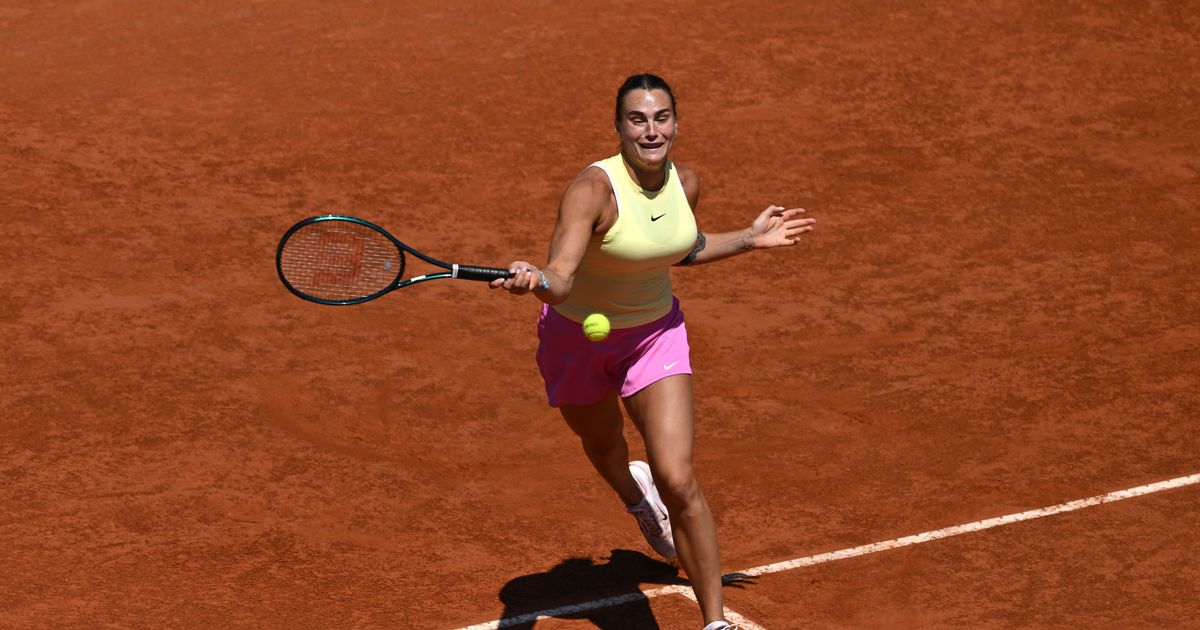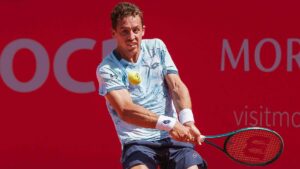
ROME — Aryna Sabalenka came into this Internazionali BNL d’Italia with a lingering illness that kept her bedridden for most of four days. She managed to muddle through her first-round match, then faced Dayana Yastremska, a player to whom she had lost all three previous professional matches, the last four years ago.
And yet, there Sabalenka was on a glorious Sunday afternoon, blowing kisses to the adoring crowd on Foro Italico’s Stadio Centrale. The No.2-seed was a 6-4, 6-2 winner over No.32 Yastremska and advanced to Monday’s Round of 16, where she’ll meet the winner of the evening match between No.16 Elina Svitolina and No.23 Anna Kalinskaya.
“I’m a better player right now — I got more stuff in my pocket to get this win against her,” Sabalenka told reporters, voice still a little scratchy. “I was going quite confident into this match knowing that I have everything to get the win.”
Thus, the two top seeds here, Sabalenka and No.1 Iga Swiatek — who met in last week’s Madrid final — are poised for a second-week run in Rome. Facing an enormous degree of difficulty, how will they fare?
For elite players, the European clay spring season is a four-tournament gauntlet that encompasses eight weeks and a potential maximum of 23 matches. Can the Eurovision Song Contest possibly be more difficult? And while much is made of the dramatic atmospheric challenges involved in achieving the Sunshine Double by winning Indian Wells and Miami, it’s arguable that this stretch is ultimately more daunting and difficult.
Coming off those United States hard court events, there’s the transition to indoor clay courts in Stuttgart. And then the altitude of Madrid, followed by the clingy red clay in Rome and Paris — amid the sultry air that makes them play even slower. Rallies are longer, the balls become heavier. Fitness and mental toughness become more of a factor. Fatigue can set in.
Swiatek, Sabalenka and Elena Rybakina have been dubbed the Big Three and there’s a good reason for that. They lead the 2024 Race to the WTA Finals by a wide margin, have carved out the best winning percentages on tour this year — and have won six of the past eight Grand Slam singles titles.
Introducing the Dirtball Double, perhaps the biggest grind in all of tennis
They’ve also taken eight straight in this bruising crucible of fire and nine of 10. Only Ons Jabeur’s win two years ago in Madrid interrupted their reign. Quite often, appropriately, it’s Swiatek, Sabalenka and Rybakina who take each other out of the tournament.
Common sense suggests that going deep in all four events is unsustainable; the Big Three usually find a way to mitigate the wear and tear by exiting at least one of those events early — or not playing at all.
After Swiatek became the World No.1 when Ashleigh Barty retired in 2022, she responded by fashioning a 37-match winning streak. She won Stuttgart but withdrew from Madrid with a shoulder injury. Swiatek went on to win in Rome and Paris, going 17-0 in those events. But in retrospect, missing Madrid probably made it possible.
What happened last year was nearly as impressive. Swiatek won Stuttgart (beating Sabalenka in the final), and reached the final in Madrid, losing to Sabalenka. In Rome, she fell to Rybakina — the eventual champion — in the quarterfinals. Memorably, Swiatek went on to win her third title at Roland Garros in four years. Her record for that clay gauntlet? A tidy 19-2.
Which begs the question: After winning Madrid for the first time, can she follow that up by winning in Rome and Paris again as she did in 2022? Serena Williams is the only player to navigate those three tournaments with consecutive wins, in 2013. Swiatek’s path is steeper, however, with Rome and Madrid undergoing recent expansions to a two-week format.
On Monday, Swiatek faces Angelique Kerber in the Round of 16. Swiatek has dropped only nine games through her first two matches and has looked reasonably sharp. Compared to last year, Swiatek said she’s feeling good.
“I’m still focusing on the same things, but I remember last year I was more nervous and more stressed,” she told reporters. “I felt more pressure. This time I’m kind of using the way I feel to just enjoy everything more.”
Is she focused on winning back-to-back-to-back?
“Winning next match is on my radar,” Swiatek said. “Obviously it’s hard to win these tournaments, especially when you don’t have time to really get used to the conditions if you play well in Madrid. We’ll see.”
Last year, Sabalenka put together a nice clay run, reaching the final at Stuttgart, winning Madrid and making the semifinals in Paris to go a combined 14-3. The one clunker? Rome, where she lost her first match to Sofia Kenin. It almost happened again last week, when Sabalenka dropped the first set to qualifier Katie Volynets but rallied to win in three sets.
Later, Sabalenka explained, “For someone who has been sick for four days and couldn’t get out of bed I think I played really quite well.”
This underlines another reality of playing through these two months. Invariably, some matches will find a player at less than their best. The good ones find a way to overcome that obstacle. The great ones do it consistently.
Sabalenka lost her second match in Stuttgart to Marketa Vondrousova but played a terrific match against Swiatek in the three-hour-plus Madrid final.
With the win over Yastremska, Sabalenka is 8-2 on Euro clay — and counting.
For her part, Rybakina is a sporty 8-1, winning the title in Stuttgart and advancing to the semifinals in Madrid. But her Rome experience never came to fruition. Citing an illness, Rybakina did not defend her title.
Swiatek, Sabalenka and Rybakina were all born within a span of three years or so. Swiatek turns 23 at the end of May, Sabalenka’sth birthday was last week, and Rybakina turns 25 in June. Clearly, they are in their prime, especially on clay.
Now, after a rousing final that left both players depleted, how will Swiatek and Sabalenka rally in Rome’s second week?
For Sabalenka, these two months demand more of a macro approach.
“I’m not focusing on finding my best tennis,” she said, “I’m focusing on adapting to the conditions as good as I can, just fight for every opportunity.
“I think Madrid was really great couple of weeks for me. I took lots of positive stuff from there. Here in Rome, I just want to keep building the level so by the time I come to Roland Garros, I’ll feel my best, in my best form.”
Source: https://www.wtatennis.com/news/4008621/sabalenka-and-swiatek-look-to-cement-clay-court-supremacy-in-rome


